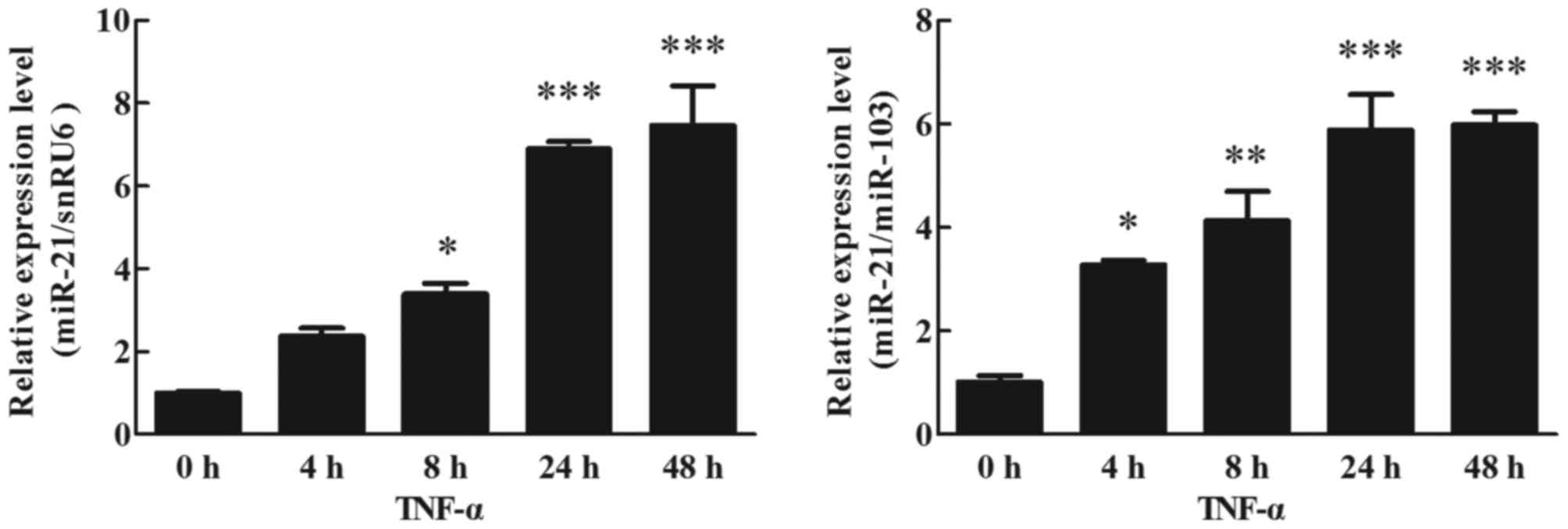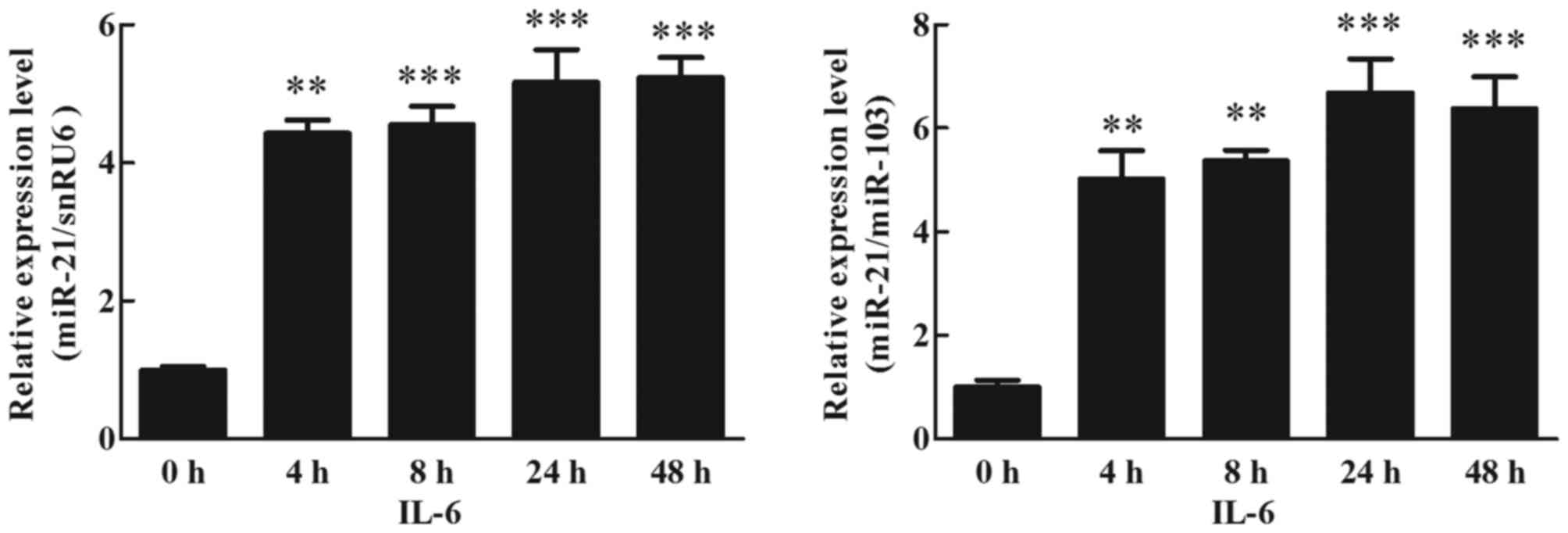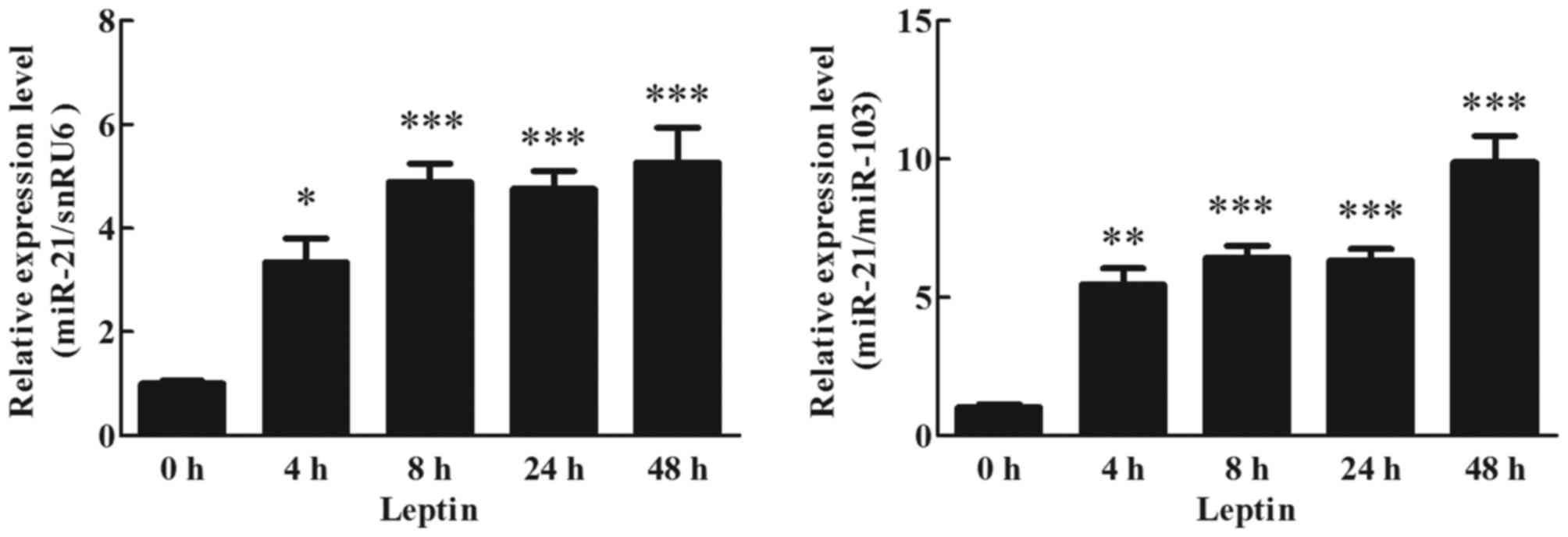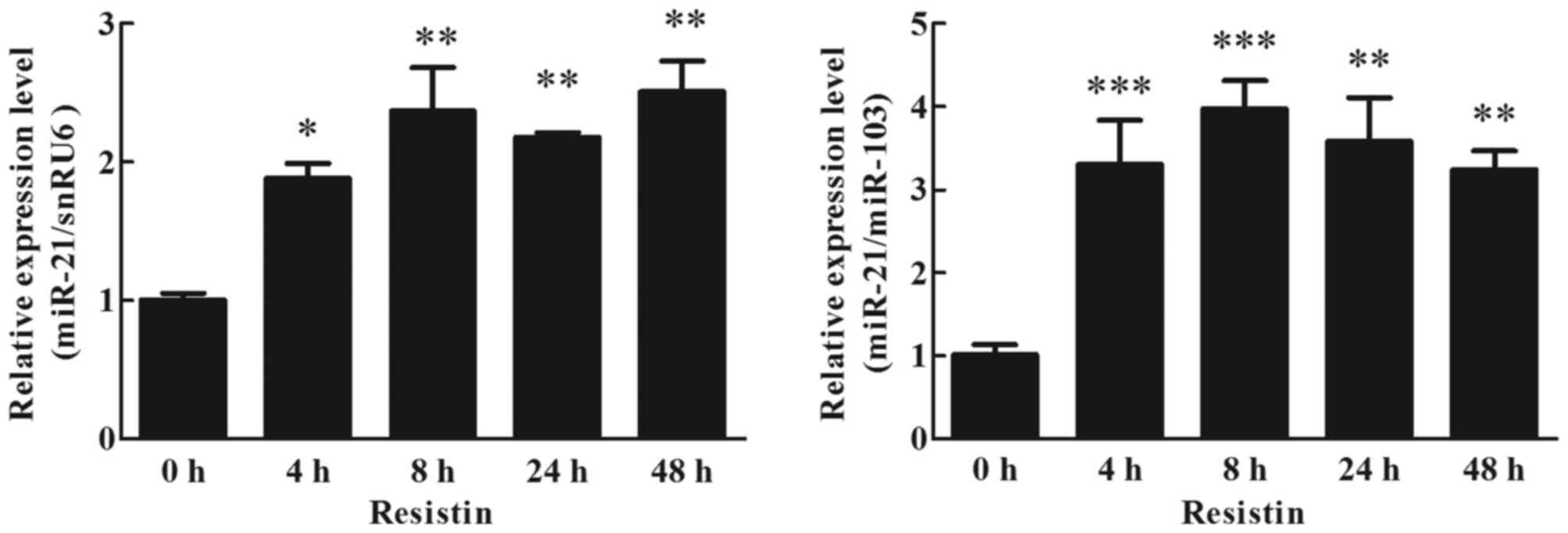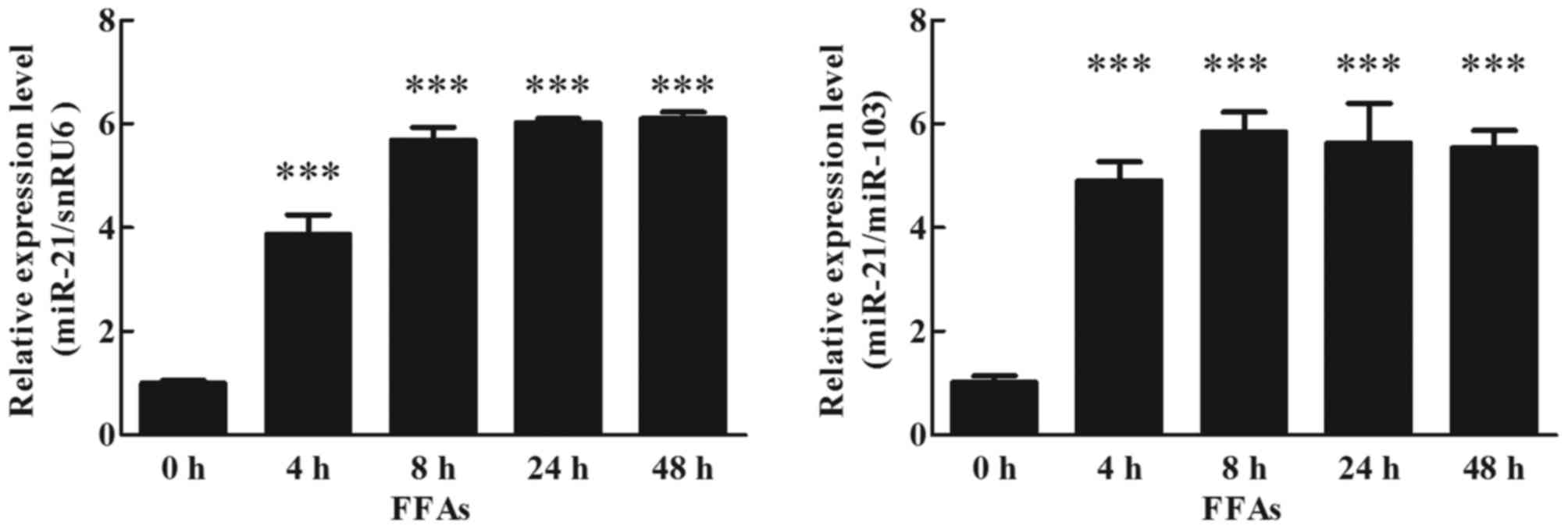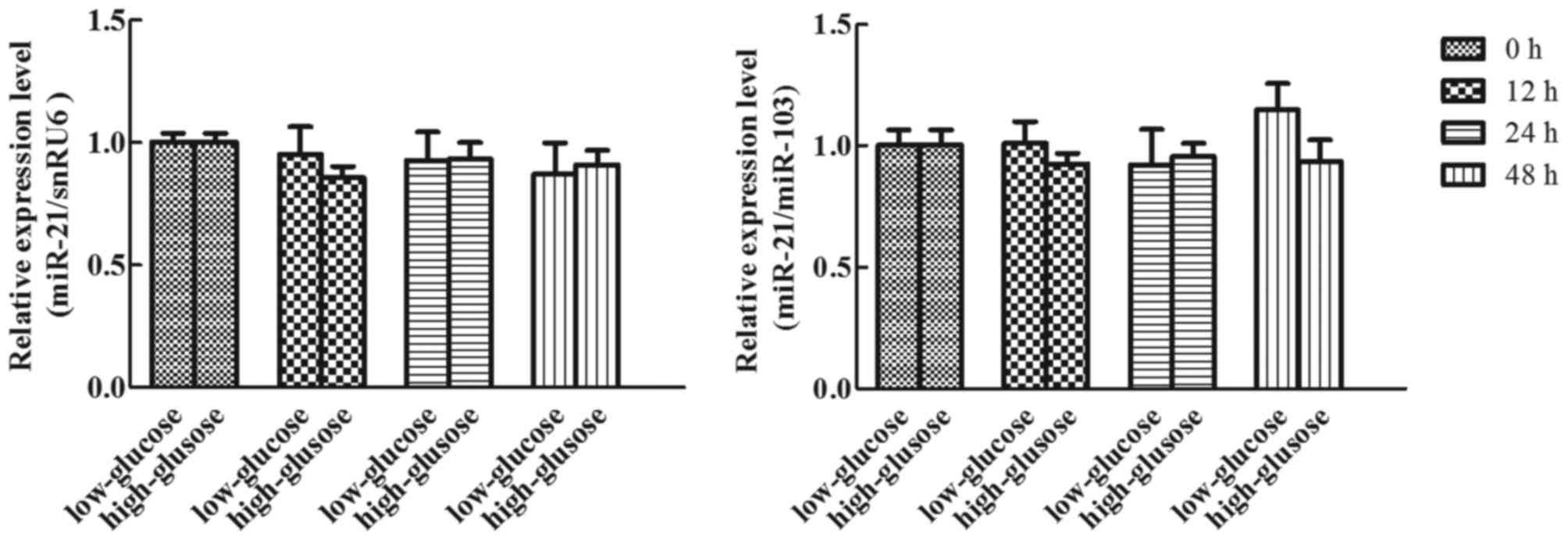Adipokines and free fatty acids regulate insulin sensitivity by increasing microRNA-21 expression in human mature adipocytes
- Authors:
- Published online on: June 14, 2017 https://doi.org/10.3892/mmr.2017.6769
- Pages: 2254-2258
Abstract
Introduction
The prevalence of obesity among children and adolescents has greatly increased and has become a global public health concern in recent decades (1). Obesity is classified as an excessive accumulation of adipose tissue due to an increase in cell number and volume. Adipose tissue stores a great deal of energy and secretes large amounts of adipokines, including tumor necrosis factor-α (TNF-α), interleukin-6 (IL-6), leptin and resistin (2). These are associated with an increased risk of several common diseases, including obesity, insulin resistance, diabetes, hypertension, angiocardiopathy and cancers (3). Additionally, free fatty acids (FFAs) and glucose, as energy-source materials, are associated with obesity and obesity-associated insulin resistance (4,5). However, the molecular mechanisms of the effects of these adipokines and energy-source materials on obesity and obesity associated insulin resistance remain to be fully elucidated.
Consequently, the present study aimed to examine the potential molecular mechanisms of adipokines and energy-source materials affecting obesity development and obesity-associated insulin resistance in human mature adipocytes. MicroRNAs (miRs), which are small non-coding RNAs that regulate gene expression at post-transcriptional level, are involved in the regulation of adipogenesis, obesity, insulin resistance and diabetes (6). miR-21 is one of the most researched miRNAs with regards to cellular growth, proliferation, apoptosis and migration (7). The use of miR-21 as a potential molecular marker has been the focus of numerous studies in recent years (8,9). Previous reports have indicated that miR-21 is associated with metabolic syndrome and is involved in human adipose tissue-derived mesenchymal stem cell (hASC) proliferation and differentiation (10–13). Therefore, miR-21 may be a key regulatory factor of obesity and obesity-associated insulin resistance.
The aim of the present study was to investigate the effects of adipokines and energy-source materials on miR-21 expression in human mature adipocytes, and to preliminarily assess the potential role of adipokines and energy-source materials via observing the impact of miR-21 in obesity and obesity-associated insulin resistance.
Materials and methods
Cell culture, differentiation and treatment
Human preadipocytes (ScienCell Research Laboratories, Inc., Carlsbad, CA, USA) were supplemented with 5% fetal bovine serum, 1% preadipocyte growth supplement and 1% penicillin/streptomycin solution (all from ScienCell Research Laboratories, Inc.) at 37°C in 5% CO2, and maintained in preadipocyte medium (PAM; ScienCell Research Laboratories, Inc.). In order to induce differentiation, confluent human preadipocytes (day 0) were cultured in serum-free PAM containing 50 nM insulin, 100 nM dexamethasone, 0.5 mM 3-isobutyl-1-methylxanthine and 100 µM rosiglitazone (all from Sigma-Aldrich; Merck KGaA, Darmstadt, Germany). The medium was changed every 2 days for the first 4 days. Thereafter, the medium was replaced with serum-free PAM containing 50 nM insulin. The media was replaced every 2 days, until accumulation of lipid droplets was observed (days 14–17). When >80% of the cells acquired the morphological and biochemical properties of mature adipocytes, cells were prepared for the experiments. Following overnight incubation in serum-free PAM, human mature adipocytes were treated with 1 mM FFAs, 10 ng/ml TNF-α, 30 ng/ml IL-6, 30 ng/ml leptin and 60 ng/ml resistin (all Sigma-Aldrich; Merck KGaA), and 5 or 25 mM glucose for 4, 8, 24 or 48 h. Adipocytes were collected and prepared for further investigation.
RNA isolation and reverse transcription-quantitative polymerase chain reaction (RT-qPCR) analysis
Total RNA was extracted from adipocytes using TRIzol® reagent (Invitrogen; Thermo Fisher Scientific, Inc.) and was quantified using the One Drop spectrophotometer. Mature miRNA quantification was performed by TaqMan miRNA analysis of miR-21. Generation of cDNA was synthesized using the TaqMan MicroRNA reverse transcription kit (Applied Biosystems; Thermo Fisher Scientific, Inc.). The reaction mixture volume was 15 µl and contained 200 ng total RNA, 50 nM stem-loop RT primer (ABI Scientific, Sterling, VA, USA) RT buffer, 0.25 mM of each dNTP, 3.33 U/ml MultiScribe reverse transcriptase and 0.25 U/ml RNase inhibitor (all Applied Biosystems; Thermo Fisher Scientific, Inc.). The thermocycling conditions were as follows: 30 min at 16°C, 30 min at 42°C, and 5 min at 85°C. For RT-qPCR, the reaction mixture contained the following: 1.33 µl (1:15 dilution) cDNA, 1.5 mM forward primer (ABI Scientific), 0.2 mM TaqMan probe (ABI Scientific), 0.7 mM reverse primer (ABI Scientific) and TaqMan Universal PCR MasterMix (all from Applied Biosystems; Thermo Fisher Scientific, Inc.) totaling 20 µl. The thermocycling conditions of reactions were as follows: 10 min at 95°C and 40 cycles of 15 sec at 95°C and 1 min at 60°C. All PCR experiments were implement using the ABI 7500 real-time PCR system (Applied Biosystems; Thermo Fisher Scientific, Inc.). The PCR results were analyzed and expressed relative to the miRNA expression of the quantitation cycle value (Cq). U6 small nucleolar RNA (snRU6) and miR-103 (ABI Scientific) were used as references to obtain the relative fold-change in expression in target samples using the comparative Cq method.
Statistical analysis
Data are presented as the mean ± standard error. Statistical analysis was performed using one-way analysis of variance followed by the Student-Newman-Keuls post hoc test, using the statistical software package SPSS (version 13.0; SPSS Inc., Chicago, IL, USA). P<0.05 was considered to indicate a statistically significant difference.
Results
Effects of TNF-α on miR-21 expression in human adipocytes
Differentiation of human preadipocytes was induced and adipocyte cultures were prepared for experiments as described in the Materials and methods section. Mature adipocytes were cultured with TNF-α (10 ng/ml) for 48 h. Using RT-qPCR (TaqMan probe method) to analyze the effects of miR-21 expression in different periods (0, 4, 8, 24 and 48 h), except for the expression of miR-21 normalized to snRU6 at 4 h, it was significantly upregulated at 4 (P<0.05), 8 (P<0.01), 24 (P<0.001) and 48 h (P<0.001) following TNF-α stimulation, when compared with the treated cells at 0 h (Fig. 1).
Effects of IL-6 on miR-21 expression in human adipocytes
To detect the effects of IL-6 on miR-21 expression in cultured human adipocytes, mature adipocytes were treated with 30 ng/ml IL-6 for 48 h, and the expression of miR-21 was analyzed using RT-qPCR (TaqMan probe method). The results indicated that IL-6 increased the expression of miR-21. At 4 h, this was 4-fold higher than the treated cells (0 h), and this increase was maintained up to 48 h (Fig. 2; P<0.05).
Effects of leptin on miR-21 expression in human adipocytes
To detect the effects of leptin on miR-21 expression in cultured human adipocytes, cultured adipocytes were treated with 60 ng/ml leptin. miR-21 expression at different time points was analyzed by RT-qPCR. Expression of miR-21 was significantly increased by 4 h following the initiation of leptin stimulation, ~4-fold higher than the treated cells (0 h), and this increase was maintained up to 48 h (Fig. 3; P<0.05).
Effects of resistin on miR-21 expression in human adipocytes
To detect the effects of resistin on miR-21 expression in cultured human adipocytes, adipocytes were cultured with 60 ng/ml resistin. The effects of resistin on miR-21 expression in cultured human adipocytes were analyzed by RT-qPCR (TaqMan probe method). The result indicated that resistin upregulated the expression of miR-21, it was ~2-fold higher than the treated cells (0 h) at 4 h, and this increase was maintained up to 48 h (Fig. 4; P<0.05).
Effects of FFAs on miR-21 expression in human adipocytes
To detect the effects of FFAs on miR-21 expression in cultured human adipocytes, mature adipocytes were cultured with 1 mM FFAs, analyzed by RT-qPCR (TaqMan probe method). The result indicated that FFAs increased expression of miR-21 at 4 h, and this increase was maintained up to 48 h (Fig. 5; P<0.05).
Effects of glucose on miR-21 expression in human adipocytes
To detect the effects of glucose on miR-21 expression in cultured human adipocytes, cultured adipocytes were treated with 5 or 25 mM glucose for different durations (0, 12, 24 and 48 h), and the expression of miR-21 was analyzed using RT-qPCR (TaqMan probe method). Following normalization using snRU6 and miR-103, the expression of miR-21 presented no statistical difference at each time-point in high or low glucose conditions (Fig. 6; P>0.05).
Discussion
Obesity is a chronic metabolic disease, which involves an excessive accumulation of adipose tissue, caused by a variety of genetic, environmental and psychosocial factors (14–16). Adipose tissue dysfunction that increases cell number and volume serves a prominent role in the development of obesity and obesity-associated insulin resistance (17). Meanwhile, TNF-α, IL-6, leptin, resistin, FFAs and glucose are associated with obesity and obesity-associated insulin resistance (2,4,5). However, the mechanisms underlying the impact of these molecules on insulin-secreting cells have not been fully clarified.
MicroRNAs, which are short non-coding RNAs that regulate gene expression at post-transcriptional level, possess important roles in various diseases, including insulin resistance, adipogenesis, obesity and diabetes (18–20). Existing research indicates that some miRNAs have been implicated in the specialized metabolic functions of mature adipocytes. For example, miR-143 is a well-characterized miRNA involved in both obesity and obesity-associated insulin resistance (21,22). In addition, studies have demonstrated that miR-21 is associated with hASC differentiation and metabolic syndrome (11–13). Therefore, further investigation of the correlation between mediators and miR-21 may provide novel insights into the underlying mechanisms of obesity and obesity-associated insulin resistance.
One of the pathogenic mechanisms underlying obesity is inflammation. TNF-α and IL-6 are major pro-inflammatory cytokines, which are produced by adipocytes and macrophages in adipose tissue (23,24). The increase of TNF-α and IL-6 serve crucial roles in obesity-associated insulin resistance and diabetes (25). In the present study, treatment with high concentrations of TNF-α and IL-6 in human mature adipocytes led to a positive effect on miR-21 expression. The results indicated that miR-21 may be a key factor associated with obesity and obesity-associated insulin resistance.
Leptin and resistin are adipocyte-derived hormones and are abundantly expressed in adipose tissue, and are linked to obesity-associated insulin resistance (26,27). In the present study, the results indicated that leptin and resistin strongly upregulated the expression of miR-21 in human mature adipocytes. Therefore, leptin and resistin may affect obesity-associated insulin resistance via promoting expression of miR-21 in human mature adipocytes.
A previous study demonstrated that high FFA levels contribute to insulin resistance in obese patients (4,28). A potential underlying mechanism is that FFAs may inhibit the insulin signaling pathway at the level of insulin-stimulated glucose transport and phosphorylation. Glucose, one of energy-source materials, has been strongly linked to obesity and its complications (5). Obesity-induced insulin resistance inhibits glucose uptake and utilization efficiency, accompanied by hyperglycemia and hyperinsulinemia. miR-21, which regulates adipocyte proliferation, differentiation and metabolic syndrome, has been confirmed to be associated with obesity (11,12). In the present study, to better understand the molecular mechanisms underlying FFAs, glucose and miR-21 with obesity and obesity-associated insulin resistance, human mature adipocytes were treated with FFAs and glucose. The expression of miR-21 was increased in FFAs treated human mature adipocytes. Notably, miR-21 expression was not significantly altered by either high or low levels of glucose stimulation. These results indicated that miR-21 may be an intermediate factor between FFAs and obesity-associated insulin resistance.
The present study indicated that miR-21 expression is promoted by TNF-α, IL-6, leptin, resistin and FFAs in human adipocytes, but is not promoted by glucose. Therefore, adipokines and energy-source materials may affect obesity development and obesity-associated insulin resistance via promoting miR-21 expression. However, the specific molecular mechanisms remain to be further explored. These findings implicate miR-21 as a potential therapeutic target for the treatment of obesity and obesity-associated insulin resistance.
Acknowledgements
The present study was support by The Natural Science Foundation of Jiangsu Province China (grant no. BK2012666).
References
|
Jeffery RW and Sherwood NE: Is the obesity epidemic exaggerated? No. BMJ. 336:2452008. View Article : Google Scholar : PubMed/NCBI | |
|
Galic S, Oakhill JS and Steinberg GR: Adipose tissue as an endocrine organ. Mol Cell Endocrinol. 316:129–139. 2010. View Article : Google Scholar : PubMed/NCBI | |
|
Haslam DW and James WP: Obesity. Lancet. 366:1197–1209. 2005. View Article : Google Scholar : PubMed/NCBI | |
|
Boden G: Obesity, insulin resistance and free fatty acids. Curr Opin Endocrinol Diabetes Obes. 18:139–143. 2011. View Article : Google Scholar : PubMed/NCBI | |
|
Parhofer KG: Interaction between glucose and lipid metabolism: More than diabetic dyslipidemia. Diabetes Metab J. 39:353–362. 2015. View Article : Google Scholar : PubMed/NCBI | |
|
Deiuliis JA: Micrornas as regulators of metabolic disease: Pathophysiologic significance and emerging role as biomarkers and therapeutics. Int J Obes (Lond). 40:88–101. 2016. View Article : Google Scholar : PubMed/NCBI | |
|
Pfeffer SR, Yang CH and Pfeffer LM: The role of miR-21 in cancer. Drug Dev Res. 76:270–277. 2015. View Article : Google Scholar : PubMed/NCBI | |
|
Beckett EL, Martin C, Choi JH, King K, Niblett S, Boyd L, Duesing K, Yates Z, Veysey M and Lucock M: Folate status, folate-related genes and serum miR-21 expression: Implications for miR-21 as a biomarker. BBA Clin. 4:45–51. 2015. View Article : Google Scholar : PubMed/NCBI | |
|
Zhao W, Zhao JJ, Zhang L, Xu QF, Zhao YM, Shi XY and Xu AG: Serum miR-21 level: A potential diagnostic and prognostic biomarker for non-small cell lung cancer. Int J Clin Exp Med. 8:14759–14763. 2015.PubMed/NCBI | |
|
Seeger T, Fischer A, Muhly-Reinholz M, Zeiher AM and Dimmeler S: Long-term inhibition of miR-21 leads to reduction of obesity in db/db mice. Obesity (Silver Spring). 22:2352–2360. 2014. View Article : Google Scholar : PubMed/NCBI | |
|
Ling HY, Hu B, Hu XB, Zhong J, Feng SD, Qin L, Liu G, Wen GB and Liao DF: miRNA-21 reverses high glucose and high insulin induced insulin resistance in 3T3-L1 adipocytes through targeting phosphatase and tensin homologue. Exp Clin Endocrinol Diabetes. 120:553–559. 2012. View Article : Google Scholar : PubMed/NCBI | |
|
Kim YJ, Hwang SH, Cho HH, Shin KK, Bae YC and Jung JS: MicroRNA-21 regulates the proliferation of human adipose tissue-derived mesenchymal stem cells and high-fat diet-induced obesity alters microrna 21 expression in white adipose tissues. J Cell Physiol. 227:183–193. 2012. View Article : Google Scholar : PubMed/NCBI | |
|
Kim YJ, Hwang SJ, Bae YC and Jung JS: miR-21 regulates adipogenic differentiation through the modulation of TGF-beta signaling in mesenchymal stem cells derived from human adipose tissue. Stem Cells. 27:3093–3102. 2009.PubMed/NCBI | |
|
Spiegelman BM and Flier JS: Obesity and the regulation of energy balance. Cell. 104:531–543. 2001. View Article : Google Scholar : PubMed/NCBI | |
|
Wellen KE and Hotamisligil GS: Inflammation, stress, and diabetes. J Clin Invest. 115:1111–1119. 2005. View Article : Google Scholar : PubMed/NCBI | |
|
Waterland RA: Epigenetic mechanisms affecting regulation of energy balance: Many questions, few answers. Annu Rev Nutr. 34:337–355. 2014. View Article : Google Scholar : PubMed/NCBI | |
|
Abranches MV, Oliveira FC, Conceição LL and Peluzio MD: Obesity and diabetes: The link between adipose tissue dysfunction and glucose homeostasis. Nutr Res Rev. 28:121–132. 2015. View Article : Google Scholar : PubMed/NCBI | |
|
Chakraborty C, Doss CG, Bandyopadhyay S and Agoramoorthy G: Influence of miRNA in insulin signaling pathway and insulin resistance: Micro-molecules with a major role in type-2 diabetes. Wiley Interdiscip Rev RNA. 5:697–712. 2014.PubMed/NCBI | |
|
Arner P and Kulyté A: MicroRNA regulatory networks in human adipose tissue and obesity. Nat Rev Endocrinol. 11:276–288. 2015. View Article : Google Scholar : PubMed/NCBI | |
|
Jinwei Z, Yi L, Yuhao W, Liujun H, Mingzhou L and Xun W: MicroRNA regulates animal adipocyte differentiation. Yi Chuan. 37:1175–1184. 2015.PubMed/NCBI | |
|
Kilic ID, Dodurga Y, Uludag B, Alihanoglu YI, Yildiz BS, Enli Y, Secme M and Bostanci HE: MicroRNA-143 and −223 in obesity. Gene. 560:140–142. 2015. View Article : Google Scholar : PubMed/NCBI | |
|
Jordan SD, Krüger M, Willmes DM, Redemann N, Wunderlich FT, Brönneke HS, Merkwirth C, Kashkar H, Olkkonen VM, Böttger T, et al: Obesity-induced overexpression of miRNA-143 inhibits insulin-stimulated AKT activation and impairs glucose metabolism. Nat Cell Biol. 13:434–446. 2011. View Article : Google Scholar : PubMed/NCBI | |
|
Olefsky JM and Glass CK: Macrophages, inflammation, and insulin resistance. Annu Rev Physiol. 72:219–246. 2010. View Article : Google Scholar : PubMed/NCBI | |
|
Hamada Y, Nagasaki H, Fujiya A, Seino Y, Shang QL, Suzuki T, Hashimoto H and Oiso Y: Involvement of de novo ceramide synthesis in pro-inflammatory adipokine secretion and adipocyte-macrophage interaction. J Nutr Biochem. 25:1309–1316. 2014. View Article : Google Scholar : PubMed/NCBI | |
|
Finucane OM, Reynolds CM, McGillicuddy FC and Roche HM: Insights into the role of macrophage migration inhibitory factor in obesity and insulin resistance. Proc Nutr Soc. 71:622–633. 2012. View Article : Google Scholar : PubMed/NCBI | |
|
Thiruvengadam V, Amperayani S, Babu RP and Uppuluri R: Correlation of childhood obesity and related insulin resistance with leptin and retinol binding protein 4. Indian J Pediatr. 82:799–804. 2015. View Article : Google Scholar : PubMed/NCBI | |
|
Park HK, Qatanani M, Briggs ER, Ahima RS and Lazar MA: Inflammatory induction of human resistin causes insulin resistance in endotoxemic mice. Diabetes. 60:775–783. 2011. View Article : Google Scholar : PubMed/NCBI | |
|
Medina-Urrutia A, Posadas-Romero C, Posadas-Sánchez R, Jorge-Galarza E, Villarreal-Molina T, González-Salazar Mdel C, Cardoso-Saldaña G, Vargas-Alarcón G, Torres-Tamayo M and Juárez-Rojas JG: Role of adiponectin and free fatty acids on the association between abdominal visceral fat and insulin resistance. Cardiovasc Diabetol. 14:202015. View Article : Google Scholar : PubMed/NCBI |



